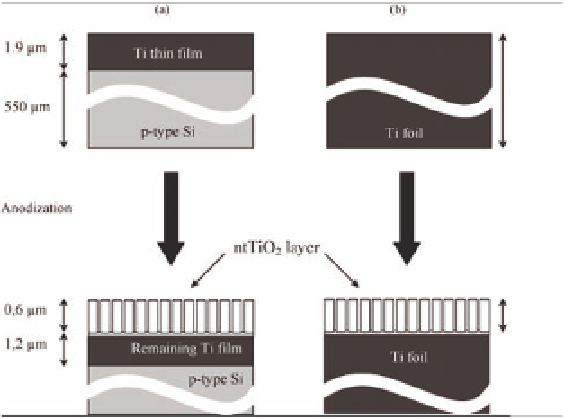Biomedical Engineering Reference
In-Depth Information
substrate consisted of commercial Ti foils from Sigma Aldrich with
a thickness of 250 and 127
μ
m and 99.7% purity. Figure 5.3 shows
the schematic representation of the fabrication of self-organized
TiO
nanotube layers onto different substrates; the principle of
fabrication will be discussed in subsequent sections.
2
(A)
(A)
(B)
(B)
~ 2
μ
m
~ 2
μ
m
250 and 127
μ
m
250 and 127
μ
m
450-550
μ
m
450-550
μ
m
Anodization
Anodization
Anodization
Anodization
600 nm
600 nm
600 and 900 nm
600 and 900 nm
~ 1.2
μ
m
~ 1.2
μ
m
grown onto two different
substrates: (a) silicon and (b) Ti foil. Reprinted from
Figure 5.3
Schematic representation of ntTiO
2
, 54,
Ortiz, G. F., Hanzu, I., Knauth, P., Lavela, P., Tirado, J. L., and Djenizian, T., “TiO
Electrochim
.
Acta
2
nanotubes manufactured by anodization of Ti thin films for on-chip Li-ion
2D microbatteries,” 4262-4268, (2009), with permission from Elsevier.
Anodization experiments were carried out by applying a constant
voltage of 20 V during a time that oscillates between 20 min and 4
h in a conventional two-electrode cell by using an EG&G PARSTAT
2273 potentiostat/galvanostat. The working electrode consisted of
titanium (Ti films sputtered onto Si and/or alternatively commercial
Ti foil), while a platinum grid served as a counterelectrode. Both
electrodes were kept in a distance of 3 cm and the electrolyte was a
solution of 1 M H
, 1M NaOH and 0.5 wt% HF. Prior to anodization,
Ti was cleaned by sonicating in acetone, isopropanol, and methanol
for 30 min, and afterward, the substrates were rinsed with distilled
water and dried in Ar flow. To ensure good electronic contact of
the electrodes, a fast-drying silver paint [Ted Pella, Inc.] was used.
Optional thermal treatment at 450ºC in air was performed for 3 h.
PO
3
4












Search WWH ::

Custom Search